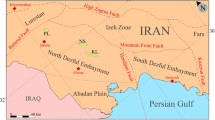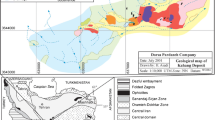Abstract
The Hokuroku district, extending over 40 × 40 km2 in northern Japan, is known to be dominated by kuroko-type massive sulfide deposits that have a genetic relation to submarine volcanic activity. The deposits are hosted in a specific stratigraphic zone of Miocene volcanic rocks. Because kuroko-type deposits are under exploration in several countries, it is important to integrate the geologic and geochemical data that have been accumulated in the Hokuroku district to characterize the distribution of deposits and produce a map of mineral potential. Thus, we collected data on multiple chemical components from 1917 rock cores at 143 drillhole sites and concentrated on components with relatively large amounts of data, which are SiO2, Al2O3, and Fe2O3 as major elements and Cu, Pb, and Zn as trace elements. Although frequencies of these data can be approximated by normal or lognormal distributions, spatial correlation structures cannot be extracted from the semivariograms of each component nor from the cross-semivariograms between two components of the major or minor elements. To handle such complexity, a spatial method of modeling content distribution, SLANS, is developed by applying a feedforward neural network. The principle of SLANS is to train a network repeatedly to recognize the relation between the data value and the location and lithology of a sample point. One-hundred outputs for each element are obtained by changing the numbers of neurons in a middle layer from 1 to 10 and sample data used for training from 3 to 12, and finally one output is selected based on the estimation precision of the network which is restricted near the target point. After constructing a geologic distribution model from the geological column classified into 25 rock codes, three-dimensional distributions of Cu, Pb, and Zn contents are estimated over the study area. The content models are considered to be valid because high-content zones are located on the known mine sites and the margins of ancient volcanoes or calderas. Some zones are distributed along strikes of major deep-seated fractures in the district.
Similar content being viewed by others
REFERENCES
Aarts, E. H. L., and Korst, J. H. M., 1990, Simulated annealing and Boltzmann machines: Wiley, New York, 267 p.
Benediktsson, J. A., Swain, P. H., and Ersoy, O. K., 1990, Neural network approaches versus statistical methods in classification of multisource remote sensing data: IEEE Trans. Geosci. Remote Sens., v. 28, no. 3, p. 540-552.
Chang, H.-C., Cheng, H.-C., and Fang, J.-H., 1997, Lithology determination from well logs with fuzzy associative memory neural network: IEEE Trans. Geosci. Remote Sens., v. 35, no. 3, p. 773-780.
David, M., 1977, Geostatistical ore reserve estimation: Elsevier, Amsterdam, The Netherlands, 364 p.
David, M., 1988, Handbook of applied advanced geostatistical ore reserve estimation: Elsevier, Amsterdam, The Netherlands, 216 p.
Dimitrakopoulos, R., ed., 1994, Geostatistics for the next century: Kluwer, Dordrecht, The Netherlands, 497 p.
Doraisamy, H., Ertekin, T., and Grader, A. S., 2000, Field development studies by neuro-simulation: An effective coupling of soft and hard computing protocols: Computers & Geosciences, v. 26, no. 8, p. 963-973.
Dowd, P. A., and Sarac, C., 1994, A neural network approach to geostatistical simulation: Math. Geology, v. 26, no. 4, p. 491-503.
Fletcher, D., and Goss, E., 1993, Forecasting with neural networks: an application using bankruptcy data: Inform. Manag., v. 24, p. 159-167.
Geological Survey of Japan, 2000, Gravity CD-ROM of Japan: Digital Geoscience Map, p-2.
Huang, Z., Shimeld, J., Willianson, M., and Katsube, J., 1996, Permeability prediction with artificial neural network modeling in the Venture gas field, offshore eastern Canada: Geophysics, v. 61, no. 2, p. 422-436.
Ishihara, S., ed., 1974, Geology of the kuroko deposits [Special issue]: Mining Geology, 6, 437 p.
Ishikawa, Y., 1991, Kuroko: Kyoritsu Shuppan, Tokyo, Japan, 119 p. (in Japanese).
Journel, A. G., and Huijbregts, Ch. J., 1978, Mining geostatistics: Academic Press, London, 600 p.
Koike, K., Gu, B., and Ohmi, M., 1998, Three-dimensional distribution analysis of phosphorus content of limestone through a combination of geostatistics and artificial neural network: Nonrenewable Resources, v. 7, no. 3, p. 197-210.
Koike, K., Matsuda, S., and Gu, B., 2001, Evaluation of interpolation accuracy of neural kriging with application to temperature-distribution analysis: Math. Geology, v. 33, no. 4, p. 421-448.
Koike, K., Minta, T., Ishizaka, S., and Ohmi, M., 1996, Hydrogeological and ground-water resource analysis using a geotechnical database: Nonrenewable Resources, v. 5, no. 1, p. 23-32.
Koike, K., Shiraishi, Y., Verdeja, E., and Fujimura, K., 1998, Three-dimensional interpolation and lithofacies analysis of granular coposition data for earthquake-engineering characterization of shallow soil: Math. Geology, v. 30, no. 6, p. 733-759.
Kouda, R., and Koide, H., 1978, Ring structures, resurgent cauldron and ore deposits in the Hokuroku volcanic field, Northern Akita, Japan: Mining Geology, v. 28, no. 4, p. 233-244.
Kumar, J. K., Konno, M., and Yasuda, N., 2000, Subsurface soil-geology interpolation using fuzzy neural network: Jour. Geotech. Geoenviron. Eng., v. 126, no. 7, p. 632-639.
Lambert, I. B., and Sato, T., 1974, The kuroko and associated ore deposits of Japan: A review of their features and metallogenesis: Econ. Geology, v. 69, no. 8, p. 1215-1236.
Miller, D. M., Kaminsky, E. J., and Rana, S., 1995, Neural network classification of remote-sensing data: Computers & Geosciences, v. 21, no. 3, p. 337-386.
MITI, 1983, Report of regional investigations for 1982 (FY): general investigation for statistical analysis: Ministry of International Trade and Industry and Agency of Resources Energy, Tokyo, Japan, 621 p. (in Japanese).
MITI, 2000, Report of exploration technology and development of mineral resources for 1999 (FY): development of expert system: Ministry of International Trade and Industry and Agency of Resources Energy, Tokyo, Japan, 361 p. (in Japanese).
MMAJ, 1980, Report of close investigations for 1979 (FY): The Hokuroku district: Metal Mining Agency of Japan, Tokyo, Japan, 160 p. (in Japanese).
Nakajima, T., 1989, Explanatory text of the geological map for mineral resources assessment of the Hokuroku district, scale 1:50,000, Miscellaneous Map Series 27: Geol. Survey Japan, 107 p. (in Japanese, with English abstract, 10 p.).
Ohmoto, H., and Skinner, B. J., eds., 1983, The kuroko and related volcanogenic massive sulfide deposits: Econ. Geology, Monograph 5, 604 p.
Ouenes, A., 2000, Practical application of fuzzy logic and neural networks to fractures reservoir characterization: Computers & Geosciences, v. 26, no. 8, p. 953-962.
Rumelhart, D. E., Hinton, G. E., and Williams, R. H., 1986, Learning representations by back-propagating errors: Nature, v. 323, no. 9, p. 533-536.
Rizzo, D. M., and Doughetry, D. E., 1994, Characterization of aquifer properties using artificial neural networks: Neural kriging: Water Resources Res., v. 30, no. 2, p. 483-497.
Salu, Y., and Tilton, J., 1993, Classification of multispectal image data by the binary diamond neural network and by nonparametric, pixel-by-pixel-methods: IEEE Trans. Geosci. Remote Sens., v. 31, no. 3, p. 606-617.
Sato, T., 1977, Kuroko deposits: Their geology, geochemistry and origin, in Gass, I. G., ed., Volcanic Processes in Ore Genesis: Geol. Soc. London, Spec. Publ. 7, p. 153-161.
Scott, S. D., 1978, Structural control of the kuroko deposits of the Hokuroku district, Japan: Mining Geology, v. 28, no. 4, p. 301-311.
Shin, H.-S., and Salas, J. D., 2000, Regional drought analysis based on neural network: Jour. Hydrologic Eng., v. 5, no. 2, p. 145-155.
Singer, D. A., and Kouda, R., 1988, Integrating spatial and frequency information in the search for kuroko deposits of the Hokuroku District, Japan: Econ. Geology, v. 83, no. 1, p. 18-29.
Singer, D. A., and Kouda, R., 1996, Application to a feedforward neural network in the search for kuroko deposits in the Hokuroku District, Japan: Math. Geology, v. 28, no. 8, p. 1017-1023.
Singer, D. A., and Kouda, R., 1997, Classification of mineral deposits into types using mineralogy with a probabilistic neural network: Nonrenewable Resources, v. 6, no. 1, p. 27-32.
Verly, G., David, M., Journel, A. G., and Maréchal, A., eds., 1984, Geostatistics for natural resources characterization: Reidel, Dordrecht, Holland, 1125 p.
Wong, P. M., Jang, M., Cho, S., and Gedeon, T. D., 2000, Multiple permeability predictions using an observational learning algorithm: Computers & Geosciences, v. 26, no. 8, p. 907-913.
Yamaoka, K., 1976, On the genetic problems of the vein-type deposits of the Neogene age in the inner northeast Japan: Mining Geology, v. 7 (Special issue on Geology of the Kuroko Deposits) p. 59-74 (in Japanese, with English abstract).
Author information
Authors and Affiliations
Rights and permissions
About this article
Cite this article
Koike, K., Matsuda, S., Suzuki, T. et al. Neural Network-Based Estimation of Principal Metal Contents in the Hokuroku District, Northern Japan, for Exploring Kuroko-Type Deposits. Natural Resources Research 11, 135–156 (2002). https://doi.org/10.1023/A:1015520204066
Issue Date:
DOI: https://doi.org/10.1023/A:1015520204066




